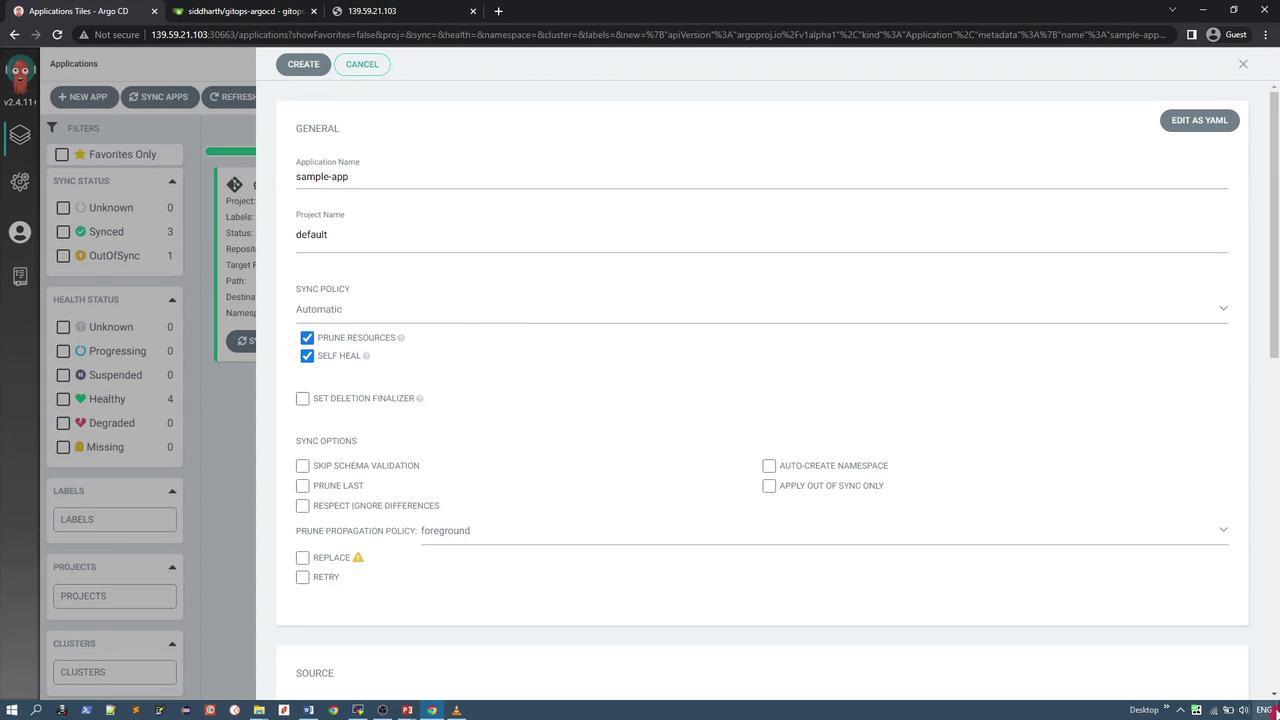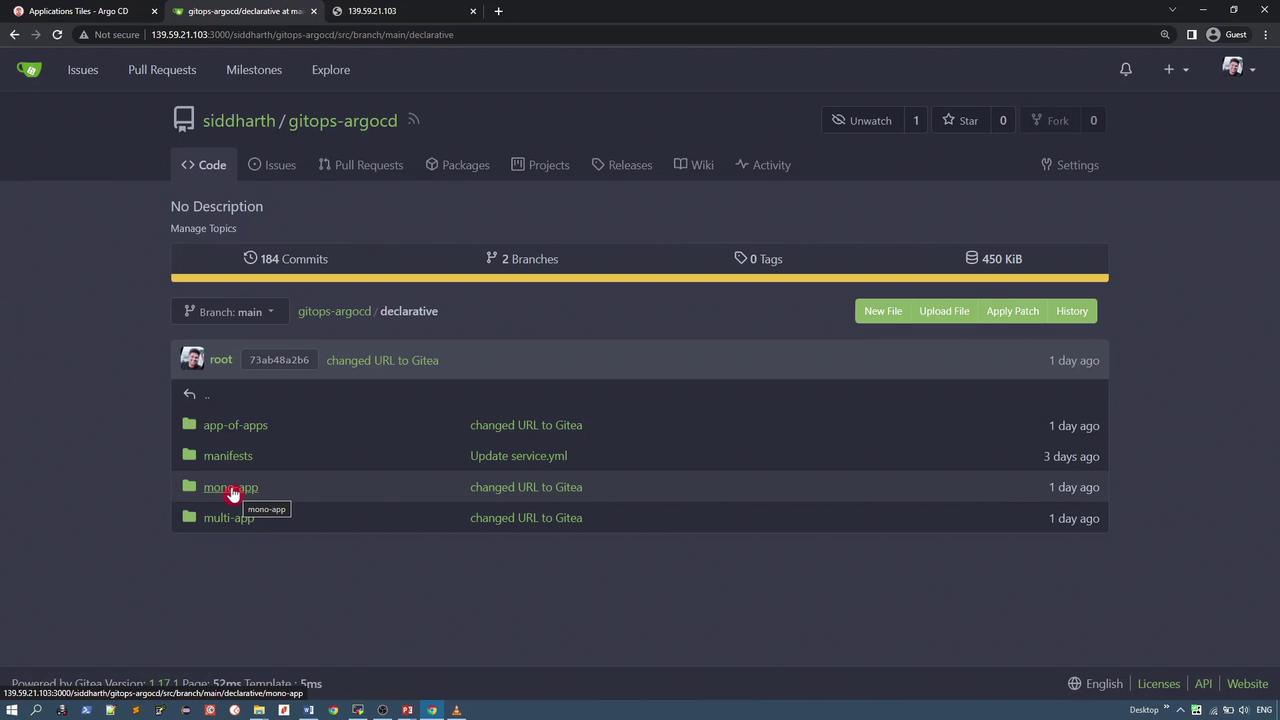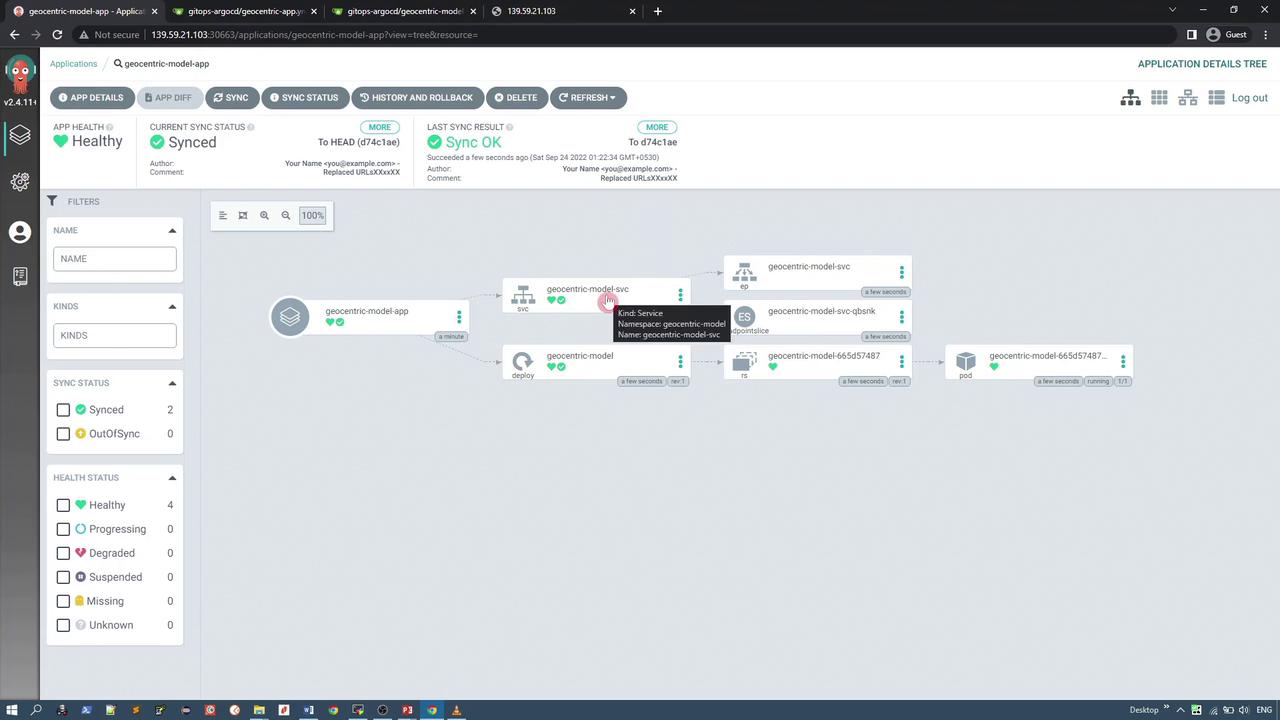GitOps with ArgoCD
ArgoCD Intermediate
Declarative Setup Mono Application
In this lesson, you will learn how to manage a single ArgoCD application declaratively. Unlike previous approaches using the ArgoCD CLI or UI, this method involves storing and managing ArgoCD application manifests in a Git repository—just like any other Kubernetes deployment or service manifest.

Within the ArgoCD UI, you define application metadata, source, and destination details. Behind the scenes, this creates a YAML specification that describes the application. Below is an example manifest:
apiVersion: argoproj.io/v1alpha1
kind: Application
metadata:
name: sample-app
spec:
destination:
namespace: sample
server: https://kubernetes.default.svc
source:
path: ./sample
repoURL: http://139.59.21.103:3000/siddhanth/gitops-argocd
targetRevision: HEAD
project: default
syncPolicy:
automated:
prune: true
selfHeal: true
Note
ArgoCD can automatically create and manage applications using YAML specifications stored in Git repositories.
Creating a Declarative ArgoCD Application
To set up a single ArgoCD application using the declarative approach, follow these steps:
- Locate the Repository Directory
In your GitOps ArgoCD repository, find the "MonoApplication" directory. In this example, the application manifest is stored in the "mono-app" directory. For instance, you should see a file namedgeocentric-app.yml.

Review the YAML Manifest
Below is an excerpt from thegeocentric-app.ymlfile that defines the ArgoCD application. This example includes essential fields such as kind, API version, project, and source details:apiVersion: argoproj.io/v1alpha1 kind: Application metadata: name: geocentric-model-app namespace: argocd finalizers: - resources-finalizer.argocd.argoproj.io spec: project: default source: repoURL: http://165.22.209.118:3000/siddharth/gitops-argocd.git targetRevision: HEAD path: ./declarative/manifests/geocentric-model destination: server: https://kubernetes.default.svc namespace: geocentric-model syncPolicy: syncOptions: - CreateNamespace=true automated: prune: true selfHeal: trueThis manifest directs ArgoCD to fetch the application manifests from the specified directory, deploy them into the
geocentric-modelnamespace, and enable automated sync with pruning and self-healing capabilities.Tip
Duplicate YAML snippets have been consolidated for clarity. Use the same manifest to ensure consistency across deployments.
Deploy the Application with kubectl
Follow these steps to pull the repository into your Kubernetes cluster and create the application:
Clone the repository and navigate to the
mono-appfolder:mkdir demo cd demo/ git clone http://139.59.21.103:3000/siddharth/gitops-argocd cd gitops-argocd/ llNavigate to the
declarative/mono-app/directory and confirm the contents of thegeocentric-app.ymlfile:cd declarative/mono-app/ cat geocentric-app.ymlApply the manifest in the ArgoCD namespace with the following command:
kubectl -n argocd apply -f geocentric-app.yml
Once applied, you should see the following output indicating success:
application.argoproj.io/geocentric-model-app createdVerify the Application Deployment
Confirm the application status using both the ArgoCD CLI and kubectl commands:
argocd app listThis will display the list of applications, including
geocentric-model-app.You can also verify its status with:
kubectl -n argocd get applicationsWith automated sync enabled, ArgoCD will automatically update the application. Check the ArgoCD UI to verify that both deployment and service resources are correctly deployed.
Exposing the Application
Access the deployed application via the exposed service NodePort. For example, if the service is exposed on port 30682, you can use that port to access the application's UI. Here is an example of the service manifest:
apiVersion: v1
kind: Service
metadata:
annotations:
kubectl.kubernetes.io/last-applied-configuration: >
{"apiVersion":"v1","kind":"Service","metadata":{},"labels":{"app.kubernetes.io/instance":"geocentric-model-app"},"name":"geocentric-model-svc","namespace":"geocentric-model"}
creationTimestamp: '2022-09-23T17:52:34Z'
labels:
app.kubernetes.io/instance: geocentric-model-app
name: geocentric-model-svc
namespace: geocentric-model
resourceVersion: '183808'
uid: cde596d8-4841-4ac1-bb6e-7996cffd7036
spec:
clusterIP: 10.111.125.181
clusterIPs:
- 10.111.125.181
externalTrafficPolicy: Cluster
internalTrafficPolicy: Cluster
ipFamily: IPv4
ipFamilyPolicy: SingleStack
ports:
- nodePort: 38684
port: 80
protocol: TCP
targetPort: 80
selector:
app: geocentric-model
sessionAffinity: None
type: NodePort
Warning
Ensure that the geocentric-app.yml file is created in the ArgoCD namespace to avoid any deployment issues.
Finally, observe the running application's status in the ArgoCD UI:

Summary
In this guide, you've learned how to manage a single ArgoCD application declaratively by:
- Storing the YAML manifest in a Git repository.
- Deploying the application using kubectl.
- Verifying application status via both the CLI and the ArgoCD UI.
This declarative approach simplifies application management by integrating GitOps principles, ensuring that your application's deployment is both reproducible and version-controlled.
For more detailed information on Kubernetes deployments and GitOps practices, consider exploring additional resources such as Kubernetes Documentation and ArgoCD Getting Started Guide.
Watch Video
Watch video content